Machine Learning and Deterministic Methods for Detection Meteorological Phenomena from Ground Measurements: Application for Low-Level Jet and Sea-Breeze Identification in Northern France
Abstract
1. Introduction
2. Materials and Methods
2.1. Calculation of Turbulence Parameters
2.2. Detection Methods
3. Results
3.1. Sea-Breeze Classification Results
3.2. Nocturnal Low-Level Jet Classification Results
3.3. Validation of the Algorithms Detection
3.4. Influence of NLLJ and SB on Power Production by Wind Turbines
4. Conclusions
- The proposed RNN algorithm is good enough for SB identification, having 98% sensitivity, 91% specificity, and 95% classification accuracy.
- The results obtained from the RNN algorithm are in good agreement with the independent lidar observations and show that 88% of SB events were detected during the 86-day IOP.
- Regarding NLLJ, the proposed algorithms (HWTT and SWT) detected a similar number of NLLJ events, with a R2 of 0.98 between the NLLJ detected from HWTT and that from wind lidar measurement.
- During the NLLJ events, the estimated maximum hourly average peak power generation was approximately 5 times higher than that of the reference day, and the peak power generation was 2.5 times higher during the SB events.
- The integral length scale during the NLLJ was found to be 1.25 times larger than that during SB events. Furthermore, the integral length scale during the SB was 1.6 times larger than that expected for a reference day.
Author Contributions
Funding
Acknowledgments
Conflicts of Interest
Abbreviations
| NLLJ | Nocturnal Low-Level Jet |
| SB | Sea Breeze |
| AGL | Above Ground Level |
| RNN | Recurrent Neural Network |
| IOP | Intensive Observation Period |
| TKE | Turbulence Kinetic Energy |
| HWTT | Haar Wavelet Threshold Technique |
| SWT | Symlets Wavelet slope Technique |
| SCSBC | Sign Change of Sea-Breeze Component |
| LSTM | Long Short-Term Memory |
| ADAM | ADAptive Momentum estimator |
References
- Augustin, P.; Billet, S.; Crumeyrolle, S.; Deboudt, K.; Dieudonné, E.; Flament, P.; Fourmentin, M.; Guilbaud, S.; Hanoune, B.; Landkocz, Y.; et al. Impact of Sea Breeze Dynamics on Atmospheric Pollutants and Their Toxicity in Industrial and Urban Coastal Environments. Remote Sens. 2020, 12, 648. [Google Scholar] [CrossRef]
- Mazon, J.; Rojas, J.I.; Jou, J.; Valle, A.; Olmeda, D.; Sanchez, C. An Assessment of the Sea Breeze Energy Potential Using Small Wind Turbines in Peri-Urban Coastal Areas. J. Wind Eng. Ind. Aerodyn. 2015, 139, 1–7. [Google Scholar] [CrossRef][Green Version]
- Roy, S.; Sentchev, A.; Fourmentin, M.; Augustin, P. Turbulence of Landward and Seaward Wind during Sea-Breeze Days within the Lower Atmospheric Boundary Layer. Atmosphere 2021, 12, 1563. [Google Scholar] [CrossRef]
- Augustin, P.; Delbarre, H.; Lohou, F.; Campistron, B.; Puygrenier, V.; Cachier, H.; Lombardo, T. Investigation of Local Meteorological Events and Their Relationship with Ozone and Aerosols during an ESCOMPTE Photochemical Episode. Ann. Geophys. 2006, 24, 2809–2822. [Google Scholar] [CrossRef]
- Crumeyrolle, S.; Augustin, P.; Rivellini, L.-H.; Choël, M.; Riffault, V.; Deboudt, K.; Fourmentin, M.; Dieudonné, E.; Delbarre, H.; Derimian, Y.; et al. Aerosol Variability Induced by Atmospheric Dynamics in a Coastal Area of Senegal, North-Western Africa. Atmos. Environ. 2019, 203, 228–241. [Google Scholar] [CrossRef]
- Miller, S.T.K. Sea Breeze: Structure, Forecasting, and Impacts. Rev. Geophys. 2003, 41, 1011. [Google Scholar] [CrossRef]
- Banta, R.M.; Pichugina, Y.L.; Brewer, W.A. Turbulent Velocity-Variance Profiles in the Stable Boundary Layer Generated by a Nocturnal Low-Level Jet. J. Atmos. Sci. 2006, 63, 2700–2719. [Google Scholar] [CrossRef]
- Baas, P.; Bosveld, F.C.; Baltink, H.K.; Holtslag, A.A.M. A Climatology of Nocturnal Low-Level Jets at Cabauw. J. Appl. Meteorol. Climatol. 2009, 48, 1627–1642. [Google Scholar] [CrossRef]
- Wagner, D.; Steinfeld, G.; Witha, B.; Wurps, H.; Reuder, J. Low Level Jets over the Southern North Sea. Meteorol. Z. 2019, 28, 389–415. [Google Scholar] [CrossRef]
- Schulz-Stellenfleth, J.; Emeis, S.; Dörenkämper, M.; Bange, J.; Cañadillas, B.; Neumann, T.; Schneemann, J.; Weber, I.; zum Berge, K.; Platis, A.; et al. Coastal Impacts on Offshore Wind Farms—A Review Focussing on the German Bight Area. Meteorol. Z. 2022, 31, 289–315. [Google Scholar] [CrossRef]
- Davis, P.A. Development and Mechanisms of the Nocturnal Jet. Meteorol. Appl. 2000, 7, 239–246. [Google Scholar] [CrossRef]
- Larsén, X.G.; Fischereit, J. A Case Study of Wind Farm Effects Using Two Wake Parameterizations in the Weather Research and Forecasting (WRF) Model (V3.7.1) in the Presence of Low-Level Jets. Geosci. Model Dev. 2021, 14, 3141–3158. [Google Scholar] [CrossRef]
- Rausch, T.; Cañadillas, B.; Hampel, O.; Simsek, T.; Tayfun, Y.B.; Neumann, T.; Siedersleben, S.; Lampert, A. Wind Lidar and Radiosonde Measurements of Low-Level Jets in Coastal Areas of the German Bight. Atmosphere 2022, 13, 839. [Google Scholar] [CrossRef]
- Kumar, R.; Stallard, T.; Stansby, P.K. Large-scale Offshore Wind Energy Installation in Northwest India: Assessment of Wind Resource Using Weather Research and Forecasting and Levelized Cost of Energy. Wind Energy 2021, 24, 174–192. [Google Scholar] [CrossRef]
- Seroka, G.; Fredj, E.; Kohut, J.; Dunk, R.; Miles, T.; Glenn, S. Sea Breeze Sensitivity to Coastal Upwelling and Synoptic Flow Using Lagrangian Methods. J. Geophys. Res. Atmos. 2018, 123, 9443–9461. [Google Scholar] [CrossRef]
- Garvine, R.W.; Kempton, W. Ssessing the Wind Field over the Continental Shelf as a Resource for Electric Power. J. Mar. Res. 2008, 66, 751–773. [Google Scholar] [CrossRef]
- Steele, C.J.; Dorling, S.R.; Von Glasow, R.; Bacon, J. Modelling Sea-Breeze Climatologies and Interactions on Coasts in the Southern North Sea: Implications for Offshore Wind Energy. Q. J. R. Meteorol. Soc. 2015, 141, 1821–1835. [Google Scholar] [CrossRef]
- Holtslag, M.C.; Bierbooms, W.A.A.M.; van Bussel, G.J.W. Validation of Surface Layer Similarity Theory to Describe Far Offshore Marine Conditions in the Dutch North Sea in Scope of Wind Energy Research. J. Wind Eng. Ind. Aerodyn. 2015, 136, 180–191. [Google Scholar] [CrossRef]
- Angevine, W.M.; Tjernström, M.; Žagar, M. Modeling of the Coastal Boundary Layer and Pollutant Transport in New England. J. Appl. Meteorol. Climatol. 2006, 45, 137–154. [Google Scholar] [CrossRef]
- Filho, L.M.; Roebeling, P.; Villasante, S.; Bastos, M.I. Ecosystem Services Values and Changes across the Atlantic Coastal Zone: Considerations and Implications. Mar. Policy 2022, 145, 105265. [Google Scholar] [CrossRef]
- Tsiringakis, A.; Theeuwes, N.E.; Barlow, J.F.; Steeneveld, G.-J. Interactions Between the Nocturnal Low-Level Jets and the Urban Boundary Layer: A Case Study over London. Bound. Layer Meteorol. 2022, 183, 249–272. [Google Scholar] [CrossRef]
- Sullivan, J.T.; Rabenhorst, S.D.; Dreessen, J.; McGee, T.J.; Delgado, R.; Twigg, L.; Sumnicht, G. Lidar Observations Revealing Transport of O3 in the Presence of a Nocturnal Low-Level Jet: Regional Implications for “next-Day” Pollution. Atmos. Environ. 2017, 158, 160–171. [Google Scholar] [CrossRef]
- Corsmeier, U.; Kossmann, M.; Kalthoff, N.; Sturman, A. Temporal Evolution of Winter Smog within a Nocturnal Boundary Layer at Christchurch, New Zealand. Meteorol. Atmos. Phys. 2006, 91, 129–148. [Google Scholar] [CrossRef]
- Tucker, S.C.; Banta, R.M.; Langford, A.O.; Senff, C.J.; Brewer, W.A.; Williams, E.J.; Lerner, B.M.; Osthoff, H.D.; Hardesty, R.M. Relationships of Coastal Nocturnal Boundary Layer Winds and Turbulence to Houston Ozone Concentrations during TexAQS 2006. J. Geophys. Res. 2010, 115, D10304. [Google Scholar] [CrossRef]
- Hill, S.I.; Desobry, F.; Garnsey, E.W.; Chong, Y.-F. The Impact on Energy Consumption of Daylight Saving Clock Changes. Energy Policy 2010, 38, 4955–4965. [Google Scholar] [CrossRef]
- Nanopoulos, A.; Alcock, R.; Manolopoulos, Y. Feature-Based Classification of Time-Series Data. Int. J. Comput. Res. 2001, 10, 49–61. [Google Scholar]
- Lines, J.; Taylor, S.; Bagnall, A. Time Series Classification with HIVE-COTE: The Hierarchical Vote Collective of Transformation-Based Ensembles. ACM Trans. Knowl. Discov. Data 2018, 12, 1–35. [Google Scholar] [CrossRef]
- Koley, B.; Dey, D. An Ensemble System for Automatic Sleep Stage Classification Using Single Channel EEG Signal. Comput. Biol. Med. 2012, 42, 1186–1195. [Google Scholar] [CrossRef]
- Sokolov, A.; Dmitriev, E.; Gengembre, C.; Delbarre, H. Automated Classification of Regional Meteorological Events in a Coastal Area Using In Situ Measurements. J. Atmos. Ocean. Technol. 2020, 37, 723–739. [Google Scholar] [CrossRef]
- Wang, Z.; Yan, W.; Oates, T. Time Series Classification from Scratch with Deep Neural Networks: A Strong Baseline. In Proceedings of the 2017 International Joint Conference on Neural Networks (IJCNN), Anchorage, AK, USA, 14–19 May 2017; pp. 1578–1585. [Google Scholar]
- Cui, Z.; Chen, W.; Chen, Y. Multi-Scale Convolutional Neural Networks for Time Series Classification. arXiv 2016. [Google Scholar] [CrossRef]
- Roy, S.; Sentchev, A.A.; Schmitt, F.G.; Augustin, P.; Fourmentin, M. Impact of Nocturnal Low-Level Jet and Orographic Waves on the Turbulent Motions and Energy Fluxes in the Lower Atmospheric Boundary Layer. Bound. Layer Meteorol. 2021, 180, 527–542. [Google Scholar] [CrossRef]
- Golzio, A.; Bollati, I.M.; Ferrarese, S. An Assessment of Coordinate Rotation Methods in Sonic Anemometer Measurements of Turbulent Fluxes over Complex Mountainous Terrain. Atmosphere 2019, 10, 324. [Google Scholar] [CrossRef]
- Hill, R.J. Corrections to Taylor’s Frozen Turbulence Approximation. Atmos. Res. 1996, 40, 153–175. [Google Scholar] [CrossRef]
- KiranKumar, N.V.P.; Jagadeesh, K.; Niranjan, K.; Rajeev, K. Seasonal Variations of Sea Breeze and Its Effect on the Spectral Behaviour of Surface Layer Winds in the Coastal Zone near Visakhapatnam, India. J. Atmos. Sol. Terr. Phys. 2019, 186, 1–7. [Google Scholar] [CrossRef]
- Baars, H.; Ansmann, A.; Engelmann, R.; Althausen, D. Continuous Monitoring of the Boundary-Layer Top with Lidar. Atmos. Chem. Phys. 2008, 8, 7281–7296. [Google Scholar] [CrossRef]
- Al-kadi, M.I.; Reaz, M.B.I.; Mohd Ali, M.A. Compatibility of Mother Wavelet Functions with the Electroencephalographic Signal. In Proceedings of the 2012 IEEE-EMBS Conference on Biomedical Engineering and Sciences, Langkawi, Malaysia, 17–19 December 2012; pp. 113–117. [Google Scholar]
- Andreas, E.L.; Claffy, K.J.; Makshtas, A.P. Low-Level Atmospheric Jets and Inversions Over The Western Weddell Sea. Bound. Layer Meteorol. 2000, 97, 459–486. [Google Scholar] [CrossRef]
- Svensson, N.; Arnqvist, J.; Bergström, H.; Rutgersson, A.; Sahlée, E. Measurements and Modelling of Offshore Wind Profiles in a Semi-Enclosed Sea. Atmosphere 2019, 10, 194. [Google Scholar] [CrossRef]
- Wagner, R.; Cañadillas, B.; Clifton, A.; Feeney, S.; Nygaard, N.; Poodt, M.; Martin, C.S.; Tüxen, E.; Wagenaar, J.W. Rotor Equivalent Wind Speed for Power Curve Measurement—Comparative Exercise for IEA Wind Annex 32. J. Phys. Conf. Ser. 2014, 524, 12108. [Google Scholar] [CrossRef]
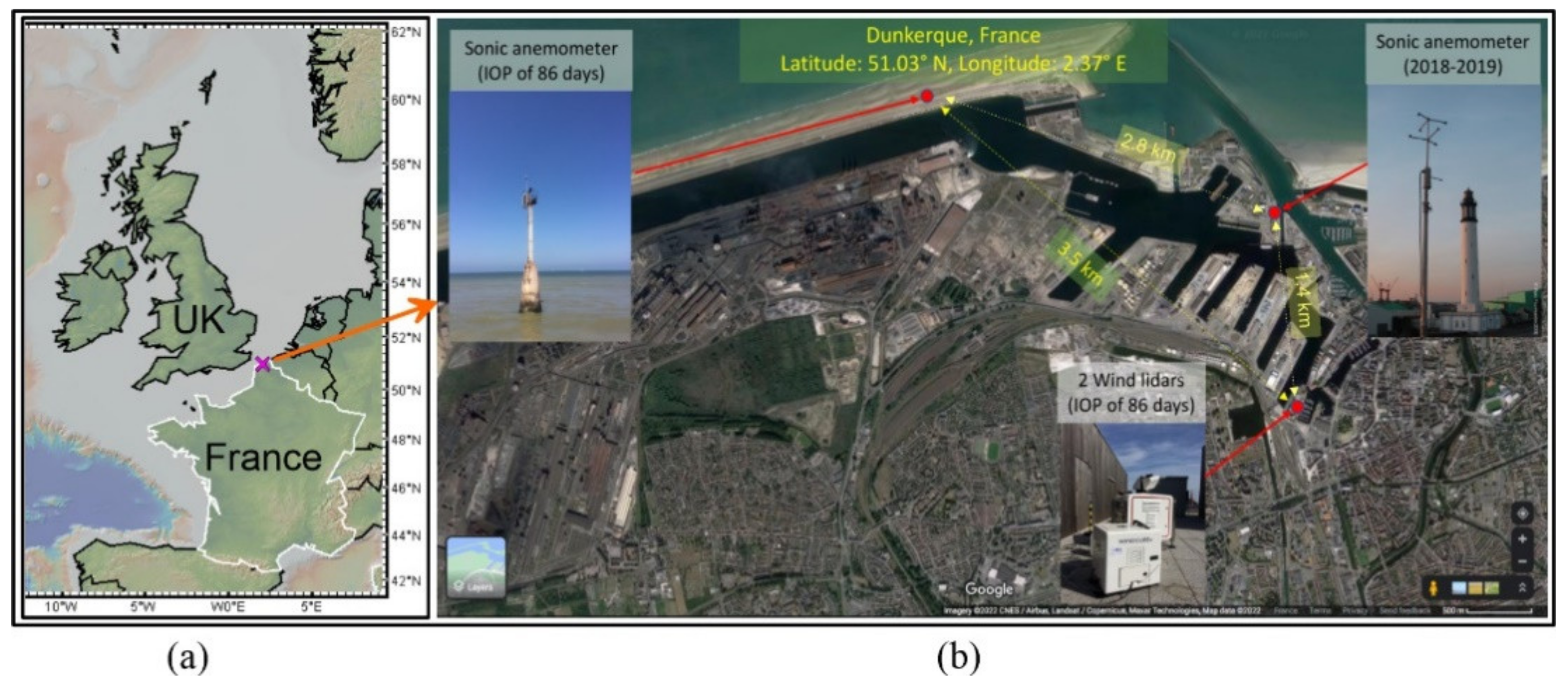
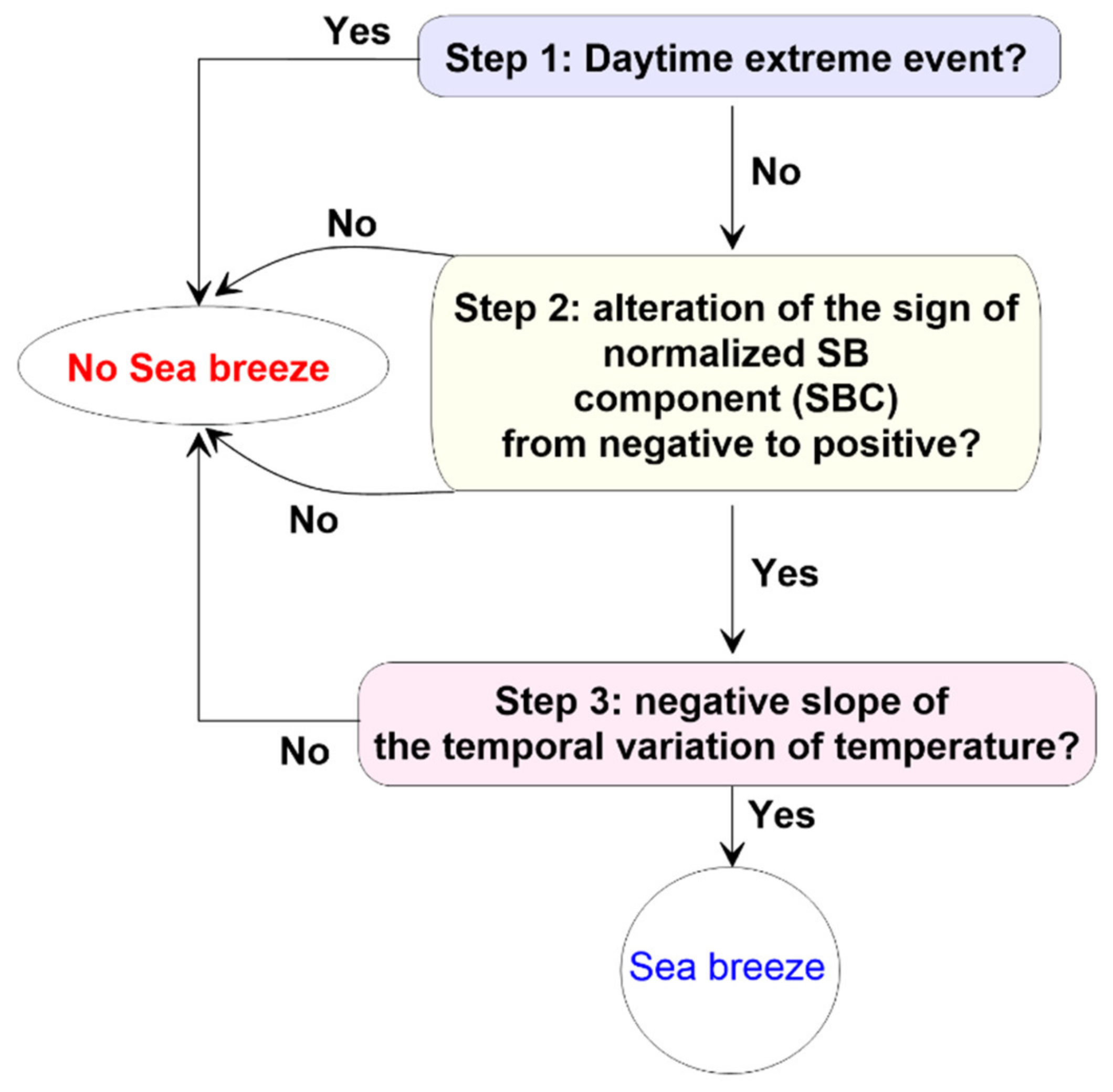
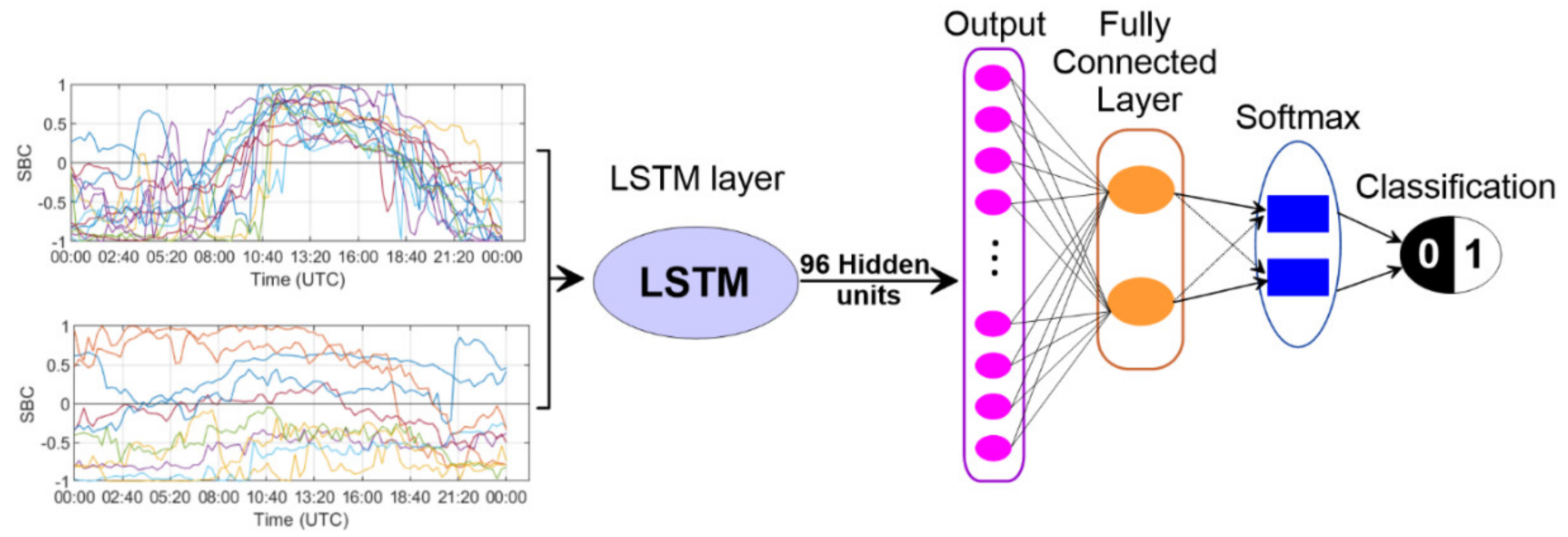
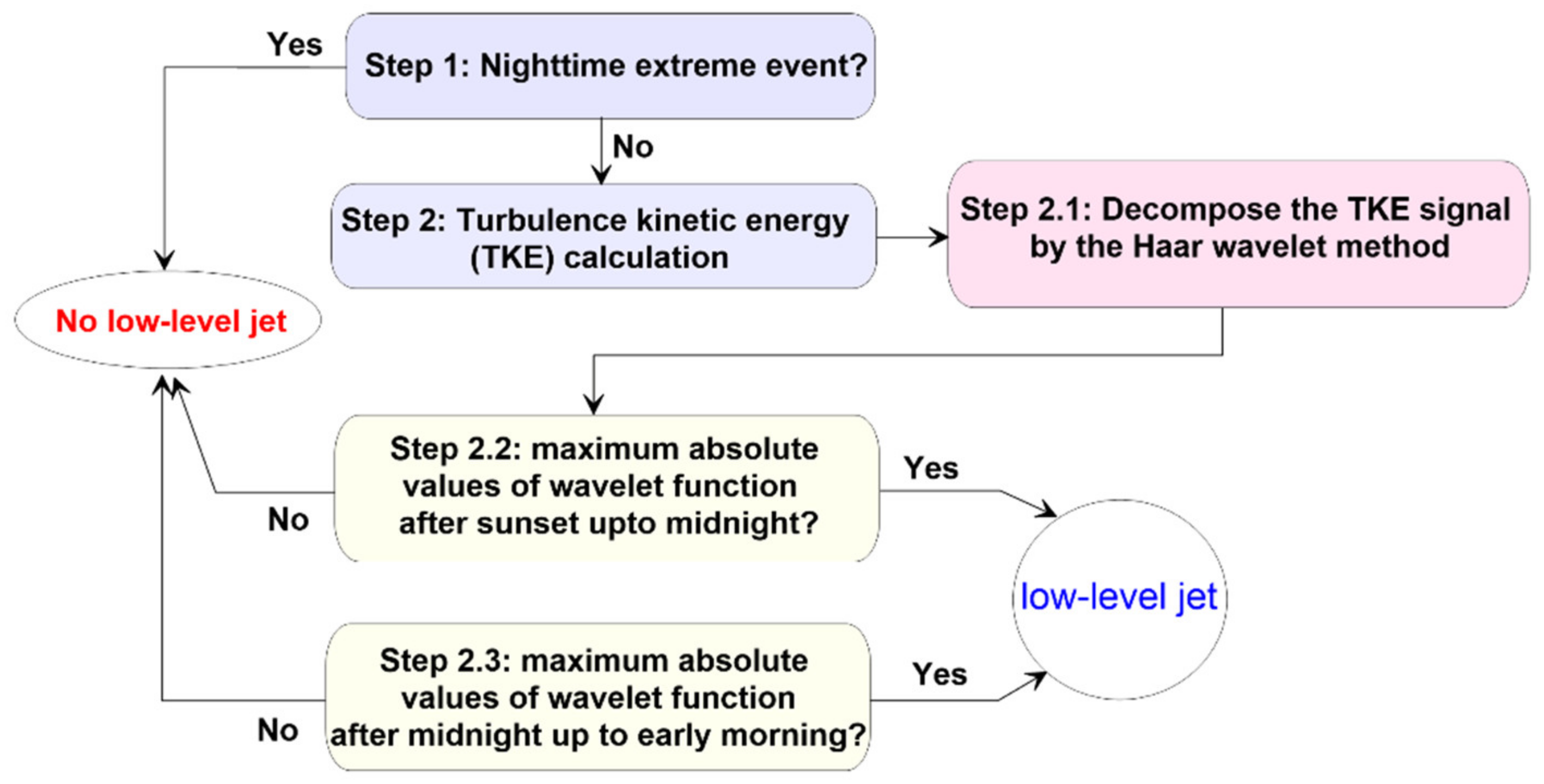
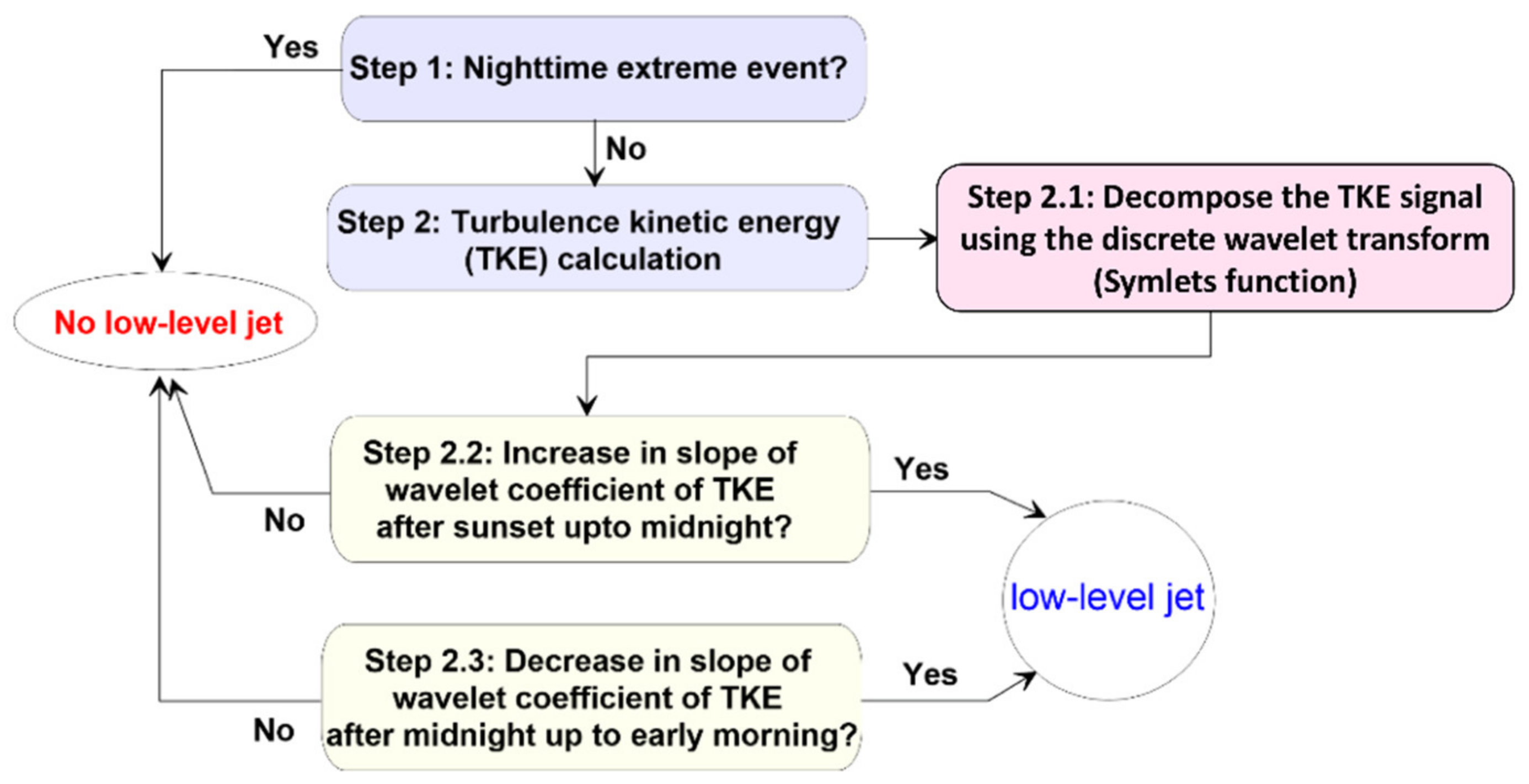
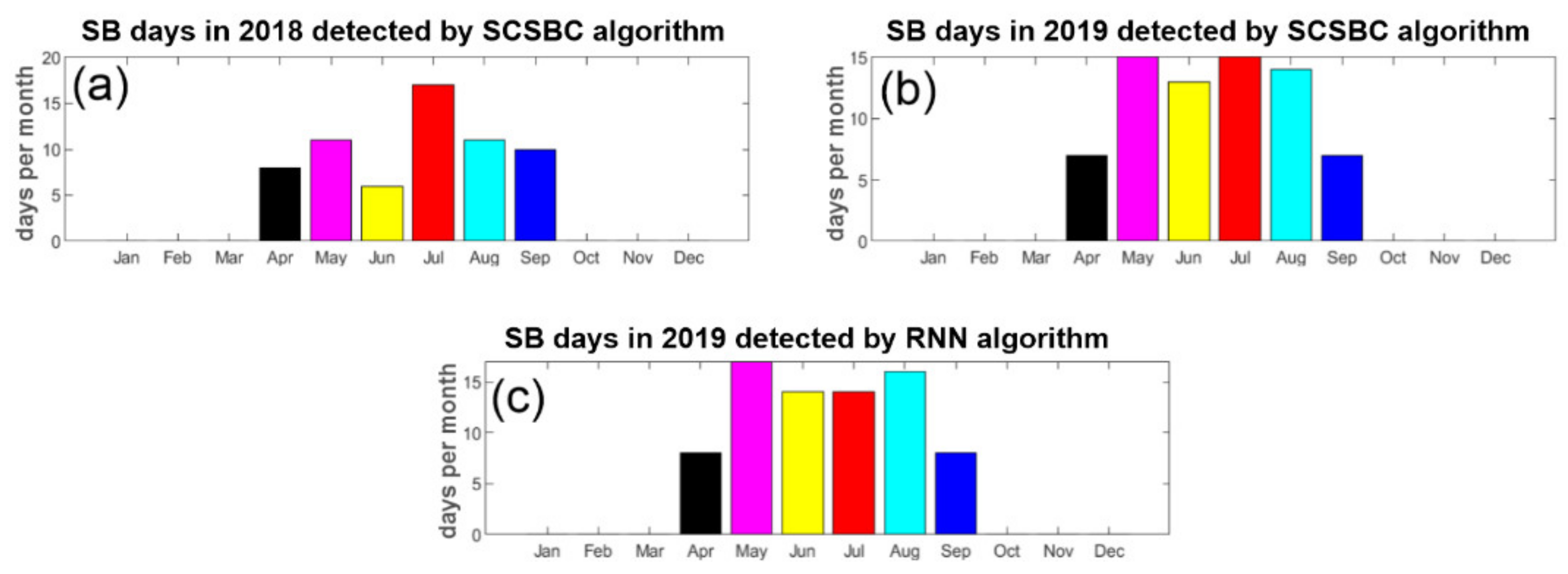




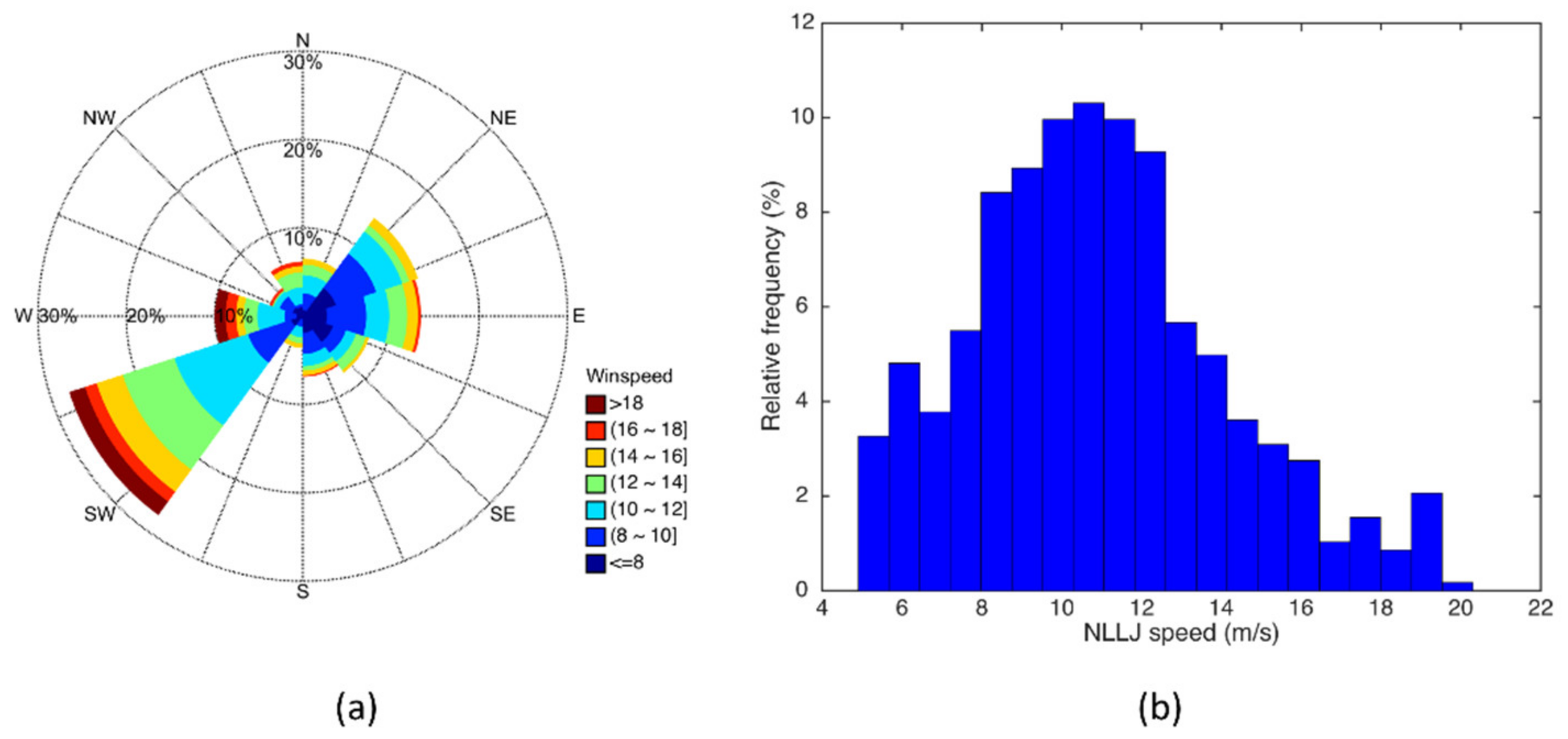
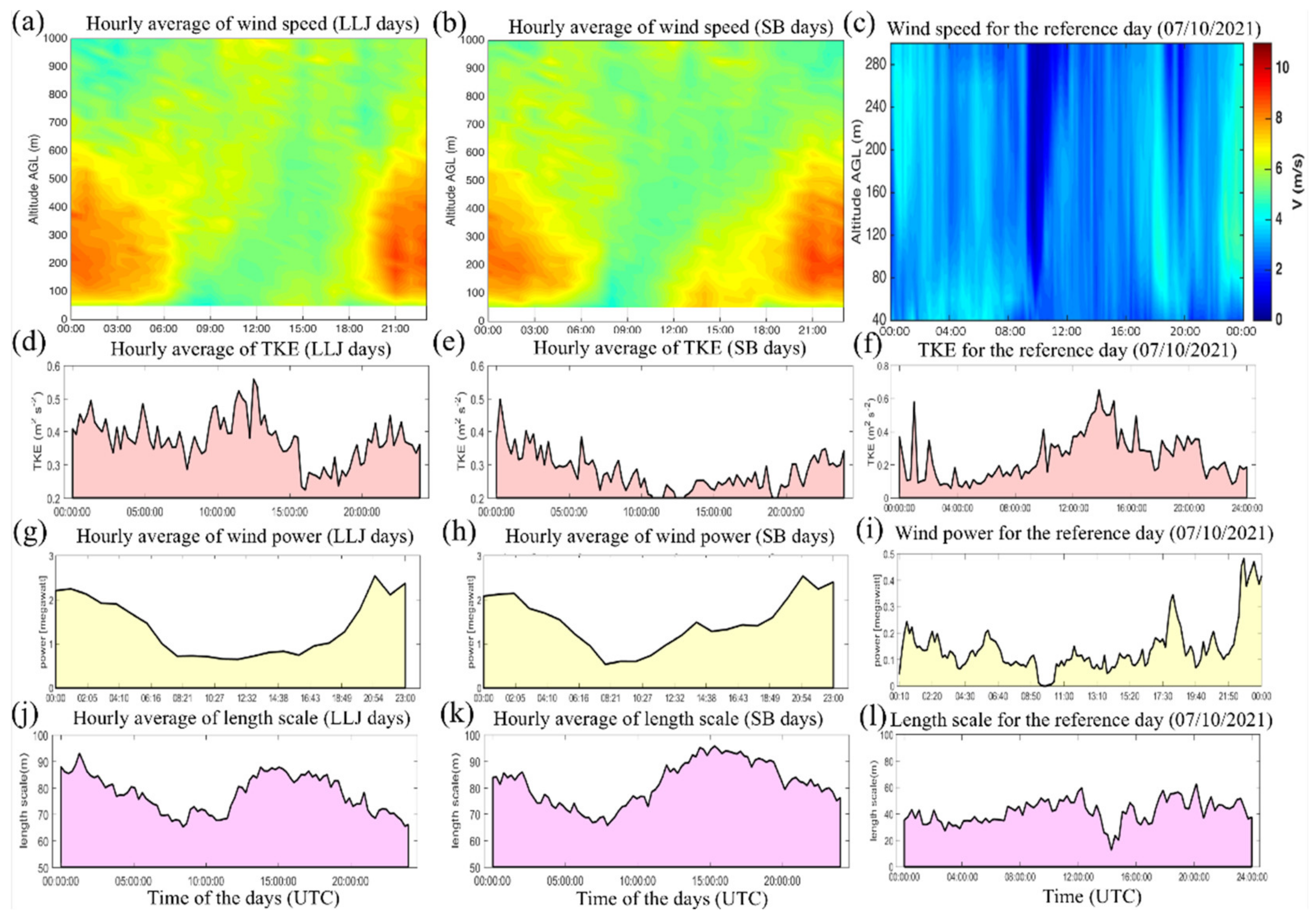
Publisher’s Note: MDPI stays neutral with regard to jurisdictional claims in published maps and institutional affiliations. |
© 2022 by the authors. Licensee MDPI, Basel, Switzerland. This article is an open access article distributed under the terms and conditions of the Creative Commons Attribution (CC BY) license (https://creativecommons.org/licenses/by/4.0/).
Share and Cite
Roy, S.; Sentchev, A.; Fourmentin, M.; Augustin, P. Machine Learning and Deterministic Methods for Detection Meteorological Phenomena from Ground Measurements: Application for Low-Level Jet and Sea-Breeze Identification in Northern France. Atmosphere 2022, 13, 1873. https://doi.org/10.3390/atmos13111873
Roy S, Sentchev A, Fourmentin M, Augustin P. Machine Learning and Deterministic Methods for Detection Meteorological Phenomena from Ground Measurements: Application for Low-Level Jet and Sea-Breeze Identification in Northern France. Atmosphere. 2022; 13(11):1873. https://doi.org/10.3390/atmos13111873
Chicago/Turabian StyleRoy, Sayahnya, Alexei Sentchev, Marc Fourmentin, and Patrick Augustin. 2022. "Machine Learning and Deterministic Methods for Detection Meteorological Phenomena from Ground Measurements: Application for Low-Level Jet and Sea-Breeze Identification in Northern France" Atmosphere 13, no. 11: 1873. https://doi.org/10.3390/atmos13111873
APA StyleRoy, S., Sentchev, A., Fourmentin, M., & Augustin, P. (2022). Machine Learning and Deterministic Methods for Detection Meteorological Phenomena from Ground Measurements: Application for Low-Level Jet and Sea-Breeze Identification in Northern France. Atmosphere, 13(11), 1873. https://doi.org/10.3390/atmos13111873






